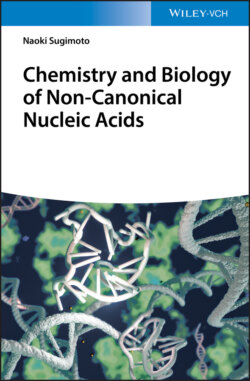Читать книгу Chemistry and Biology of Non-canonical Nucleic Acids - Naoki Sugimoto - Страница 26
2.4 Branched DNA with Junction
ОглавлениеSingle-stranded DNAs, which have a palindromic sequence in 5′ and 3′ regions in close position, form stable hairpin structure. Even though the sequence is in the duplex such as genomic DNA, addition of negative supercoiling of DNA can loosen the twist of the helix and induce the formation of such intrastranded structures. Cruciform is a structure forming two intrastrand hairpins at opposite positions within the duplex (Figure 2.6). The region producing the branched DNA structure is called junction. Similar branched DNA structure with the four-way junction is formed during homologous gene recombination that is called Holliday junction (Figure 2.6). X-ray and NMR studies of the four-way junction showed that the four arms are aligned in pairs to give an oblique “X” structure with continuity of base stacking and helical axes across the junctions. The characteristic of the structure, in which the helices formed by the branched chain coaxially stack each other, is also frequently observed in RNAs having the junction structure. This suggests importance of stacking interaction between the nucleobases that stabilizes the helix even the helices are separated by the junction. Numerous proteins have been shown to interact with the cruciform by recognizing features of the structure such as DNA crossovers, four-way junctions, and curved or bent DNA. Many of them are involved in chromatin organization, transcription, replication, DNA repair, and other processes [11].
Two pathways, S-type and C-type, have been proposed when the cruciform is formed in DNA (Figure 2.6) [12]. S-type pathway is triggered by small opening, which allows a few bases to make intrastrand base pairs as a nuclear for the branched structure. Formation of the short base pairs is followed by migration and extension of the intrastrand base pairing, which is further facilitated by negative supercoiling. C-type pathway occurs when considerably long region of duplex is melted due to franking AT-rich sequences that allows one-step formation of the mature cruciform. C-type pathway does not probably occur at physiological ion concentrations, but possibly take place in DNA regions with propensities to undergo substantial denaturation such as replication origins [13].
Figure 2.6 Structure of four-way junction to form cruciform and Holliday junction. (a) S-type and C-type pathways to form cruciform structure from long duplex. (b) Structure of Holliday junction formed by DNA strand with 5′-TCGGTACCGA-3′ sequence (PDB ID: 1M6G). Top view of four TA consecutive nucleobases at the region of interstrand exchange are shown above the structure.
